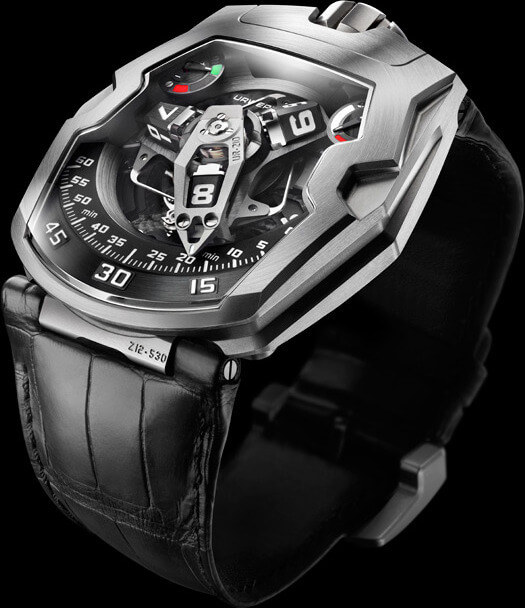“I think we’ve taken watchmaking in a new direction; we’ve opened a door,” declared Felix Baumgartner at the unveiling of the UR-210, where the principles behind this latest creation were revealed: “We wanted the wearer to be able to interact with the mechanism, to adapt it to whatever activity he’s engaged in.” “The UR-210 gives physical form to the symbiotic relationship between an individual and their watch,” added Martin Frei, cofounder with Baumgartner of Urwerk. “This humanised machine will tell you more about yourself than any other object you own.”
A milestone watch
Now in its fifteenth year, the company is back with another compelling timepiece whose design, not least the signature “satellite” time display, is pure Urwerk. “This isn’t an anniversary model,” emphasises Baumgartner. “We see the UR-210 more as a milestone, given that we machine every single part inhouse. This is a performance in itself when you consider that the aluminium minute hand, uniquely designed as fairing for the hour cube, is precision-cut with tolerances of a hundredth of a millimetre.”
The “topic of conversation” between watch and owner is power: Urwerk has equipped the UR-210 with an innovative mechanism that indicates winding efficiency over the last two hours of wearing in a display at the 11 o’clock position, opposite the power reserve. If the wearer is constantly on the move, the indicator will veer green. If, on the other hand, he’s more the armchair athlete, the hand will hover over red. As Urwerk explains: “whereas a torque indicator records mainspring tension, the readout on this display is “calculated” based on the ratio between movement winding and actual energy consumption.”

A complication that makes sense
Thus informed, the wearer then uses the winding regulator at the back of the case. At the “Full” position, the rotor converts every last movement into pure energy via a turbine coupled to the oscillating weight. The “Reduced” position, in contrast, activates a type of governor which limits the rotor so as not to “overexert” the mechanism. “A bladed turbine mounted on jewels, like an air compressor, creates an internal resistance, i.e. air friction sufficient to slow the automatic winding rotor,” says Urwerk. The system can be switched to “Stop” in which case the UR-210 is manually wound.
The front of the watch is dominated by the satellite display. “The satellite display is Urwerk’s complication and it makes as much sense as a tourbillon, if not more. We’ve always gone for the most ingenious ideas. The complication display opened up new terrain and exploring it is as exciting as ever. Frankly, we’re in love with the satellite display!” In the UR-210, it takes the form of an outsized, three-dimensional retrograde minute hand that carries the hour cube. This hand sweeps a 60-minute scale over a 120° arc, returning to its starting point in less than a tenth of a second to recommence with the next hour. As Martin Frei concludes: “The UR-210 isn’t so much a watch as a living mechanism grafted to the wrist. We’ve nicknamed it the Maltese Falcon because it gives visible form to a totally abstract notion. It is the stuff of dreams.”













